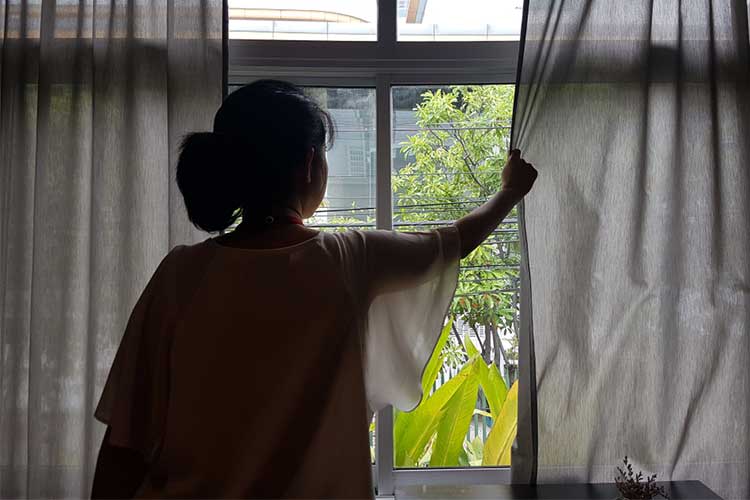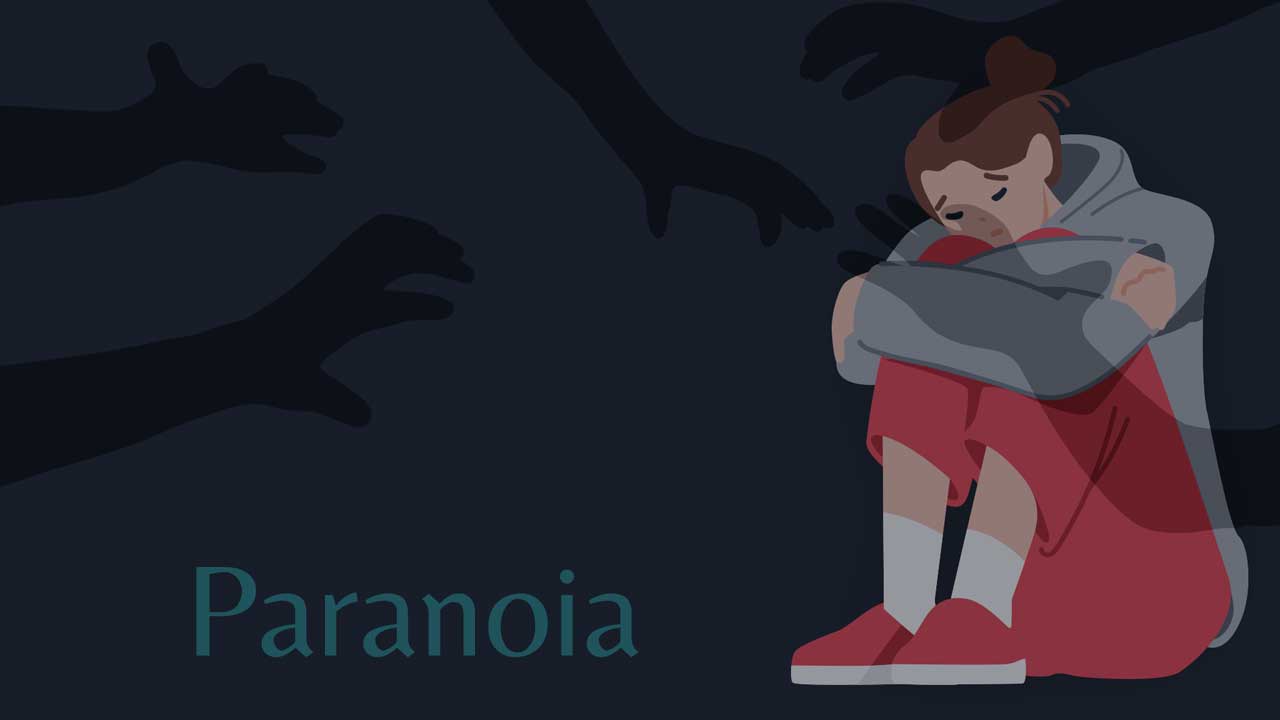What is Paranoia?
Paranoia is a breakdown of a person’s various mental and emotional functions related to reasoning and assigning meaning. It’s marked by unreasonable beliefs, often related to persecution or grandeur (Healthdirect 2024).
People who have paranoia will often experience intense anxious, fearful or delusional ideation relating to a supposed threat or harm (Healthdirect 2024).
Paranoia is most commonly seen in people who have psychotic disorders. When a person has paranoia, it’s hard or impossible to convince them that they are behaving irrationally. Beliefs become fixed and unshakable (Mental Health America 2019).

Common Types of Paranoia
1. Paranoid Personality Disorder (PPD)
- Paranoid personality disorder is characterised by long-existing and problematic thoughts, feelings and behavioural patterns.
- People who have paranoid personality disorder might be convinced that others are ‘out to get them’.
- They may present with secretive or argumentative behaviours, which might make them seem distant or difficult to bond with.
- The essential signs of this disorder are mistrust and suspicion of other people, without adequate reason.
- People with this disorder can continue to function normally despite their lack of trust in others.
(Healthdirect 2024; Better Health Channel 2022; Cleveland Clinic 2022)
2. Delusional Disorder
- A delusion is a strongly held belief that is at odds with reality.
- A delusional disorder often presents as a single fixed and false belief that is not backed up by evidence.
- Paranoid delusions are the most common, but people with this disorder may have other types of strange or unusual beliefs.
(Healthdirect 2024; Better Health Channel 2022)
Paranoia can also be a symptom of schizophrenia, psychotic disorder or bipolar disorder (Healthdirect 2024).
Symptoms of Paranoia

Paranoia symptoms may range from mild to severe. Depending on the cause they can involve the following:
- Very intense and unfounded mistrust and/or suspicion
- Hypervigilance
- Anxiety
- Fixation on the idea of ‘hidden motives’
- Being easily offended
- Mistrust
- Not coping with even mild criticism
- Reacting badly to other people’s remarks
- Being defensive, hostile, aggressive and argumentative
- Finding it difficult to forgive people
- Not being able to confide in anyone and finding relationships difficult
- Anticipating harm constantly
- Feeling targeted by the world in general
- Believing in unfounded ‘conspiracy theories’.
(Better Health Channel 2022; Mental Health America 2019)
Causes of Paranoia
The reasons as to why someone experiences paranoia are largely unknown. Paranoia is not always a result of mental illness, and it’s thought that a significant amount of the general population lives with mild paranoia (Healthdirect 2024).
Possible causes include:
- Genetics: Research is inconclusive, but paranoia has previously been linked to genetics. It is unclear whether people can inherit or be predisposed to paranoia.
- Drug use: Some researchers believe that the recreational use of certain drugs (e.g cannabis, amphetamines, cocaine) can encourage paranoid thoughts and behaviours as a result of altered brain chemistry.
- Trauma: Experiences of trauma such as enduring abuse in childhood may affect the way a person perceives threats in their day-to-day life.
- Stress: Studies have indicated that intense stress may influence the likelihood of a person developing paranoia.
- Neurological disease: Dementia, Alzheimer’s disease, Huntington’s disease, Parkinson's disease or brain injury may cause paranoia in some people.
- A combination of the above.
(Healthdirect 2024; Better Health Channel 2022)
Assessment and Diagnosis of Paranoia
A combination of the following factors may be used to diagnose paranoia:
- Mental health assessment
- Psychological testing
- Attaining a family history of mental illness
- A general medical history
- History of drug and alcohol use
- Physical examination.
(Healthdirect 2024; Better Health Channel 2022)

Treatments for Paranoia
Treatment will vary depending on the type and severity of paranoia. There is no known absolute cure, but there are treatments available to help people manage symptoms and have a better quality of life.
Medicines:
- People who have paranoia may find anti-anxiety or antipsychotic drugs useful to ease symptoms.
- They may be reluctant to embrace these medications due to fears they will cause harm.
Psychological therapy:
- Psychological therapy has the potential to relieve symptoms and improve quality of life for people who have paranoia.
- Keep in mind that a person who has paranoia might be reluctant to trust a therapist enough to talk openly with them. The key to successful therapy is building trust and fostering a collaborative relationship.
Coping mechanisms:
- More focused therapy might include relaxation therapies, therapies for anxiety and behaviour modification therapies.
- These therapies focus on helping the individual to function socially despite their paranoia.
Hospitalisation:
- In severe cases, a person who has paranoia may require a long or short stay in hospital until their condition stabilises.
(Better Health Channel 2022; Mental Health America 2019)
Caring for Patients Experiencing Paranoia
- Avoid arguing with the person
- Consider the person’s suspicions instead of immediately dismissing them
- Recognise that the person’s fears are real, even if they are based on false beliefs
- Focus on and respond to the person’s feelings underlying the paranoia
- Respect the person’s wishes
- Don’t take accusations made against you personally.
(Mind 2024; Dementia Australia 2023)
Conclusion
Paranoia ranges in severity and has the potential to significantly disrupt a person’s ability to live a happy and productive life. Fortunately, recovery is possible with time and correct treatment.
References
- Better Health Channel 2022, Paranoia, Victoria State Government, viewed 25 October 2024, https://www.betterhealth.vic.gov.au/health/conditionsandtreatments/paranoia
- Cleveland Clinic 2022, Paranoid Personality Disorder, Cleveland Clinic, viewed 25 October 2024, https://my.clevelandclinic.org/health/diseases/9784-paranoid-personality-disorder
- Dementia Australia 2023, Hallucinations and Delusions, Dementia Australia, viewed 25 October 2024, https://www.dementia.org.au/living-dementia/mood-and-behaviour-changes/hallucinations-and-delusions
- Healthdirect 2024, Paranoia, Australian Government, viewed 25 October 2024, https://www.healthdirect.gov.au/paranoia
- Mental Health America 2019, Paranoia And Delusional Disorders, Mental Health America, viewed 25 October 2024, https://www.mhanational.org/conditions/paranoia-and-delusional-disorders
- Mind 2020, Supporting Someone with Paranoia, Mind, viewed 25 October 2024, https://www.mind.org.uk/information-support/types-of-mental-health-problems/paranoia/for-friends-and-family/
Test Your Knowledge
Question 1 of 3
True or false: Paranoia is only seen in people who have psychotic disorders.
Topics
References
- Better Health Channel 2022, Paranoia, Victoria State Government, viewed 25 October 2024, https://www.betterhealth.vic.gov.au/health/conditionsandtreatments/paranoia
- Cleveland Clinic 2022, Paranoid Personality Disorder, Cleveland Clinic, viewed 25 October 2024, https://my.clevelandclinic.org/health/diseases/9784-paranoid-personality-disorder
- Dementia Australia 2023, Hallucinations and Delusions, Dementia Australia, viewed 25 October 2024, https://www.dementia.org.au/living-dementia/mood-and-behaviour-changes/hallucinations-and-delusions
- Healthdirect 2024, Paranoia, Australian Government, viewed 25 October 2024, https://www.healthdirect.gov.au/paranoia
- Mental Health America 2019, Paranoia And Delusional Disorders, Mental Health America, viewed 25 October 2024, https://www.mhanational.org/conditions/paranoia-and-delusional-disorders
- Mind 2020, Supporting Someone with Paranoia, Mind, viewed 25 October 2024, https://www.mind.org.uk/information-support/types-of-mental-health-problems/paranoia/for-friends-and-family/

